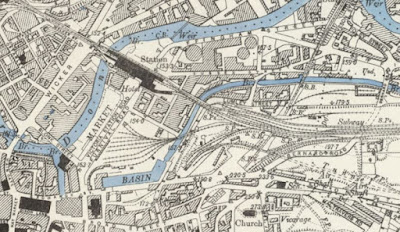As a geologist, with specialist interests in historic architecture and the building stones used in their construction, I didn’t expect to find much of interest to write about in this Language of Stone Blog, when I set out to photograph a few listed Victorian brick built buildings in the industrial area to the east of Sheffield city centre – a stable and a sick bay for horses, a canalside warehouse, a crucible steel works and a sawmill on the River Don.
However, having seen various bridges and walls, I acquired a better understanding of what I assume to be sandstone from the Parkgate Rock and perhaps the Silkstone Rock and have learned a bit more about Sheffield’s railway history – especially when looking at old Ordnance Survey maps of the east end of Sheffield.
At the Wicker Arches, I encountered another Upper Carboniferous sandstone that I could not readily identify, along with what I still believe to be Chatsworth Grit in Wicker Arch itself and after taking a quick snap of the old National Westminster Bank, I headed up The Wicker to the S.A.D.A.C.C.A. Community Centre and Social Club building – a thriving hub for the Afro-Caribbean community in Sheffield.
The Classical style house was originally built in 1853 for John Shortridge, a contractor for the Manchester, Sheffield and Lincolnshire Railway, who completed 12 km of the track through Longdendale and later built the Wicker Arches, after moving to Sheffield and forming Miller Blackie and Shortridge – and then went on to form the steel and file making firm of Shortridge, Howell and Co. with its offices at No. 48 The Wicker.
The Historic England listing doesn’t even mention its fine architectural sculpture, which had caught my attention when seeing it very many times from the top deck of the X78 bus. In my experience, this is quite typical of their descriptions, which tend to be very austere and pay very little attention to the interesting details.
In Sheffield, the work of Frank Tory and his twin sons, Alfred and William, is very well known in architectural and local history circles, but they are very rarely mentioned. In my travels around the city, I have encountered numerous excellent examples of headstops, grotesques and gargoyles at various Victorian churches and cemetery chapels, as well as on buildings in the city centre, and the sculptors deserve recognition.
At ground floor level, there are four ornately carved corbels, with two carved with fish and the sheaf of arrows from the Sheffield crest and the others bearing a date and the name of J. Shortridge, which have a pair of elephants carved on them.
Each of the ground floor arches has an ornamented keystone, with a hammer with a cog in the centre, with two bearded heads flanking it. Looking closely at the latter, they both have strange ram’s horn like detailing around the top of the head, which seems quite unusual.
On the rusticated first floor, there are further ornamented keystones to the 3 round-arched recesses with voussoirs, which each containing a Venetian window. The sculpted heads to the keystones remind me of the various heads of sea gods that I have seen in many places. I have to say that I was too busy taking photos to take much notice of the sandstone used in its construction, which from these looks like it could be a medium grained gritstone from Derbyshire.
A plaque commemorates Samuel Osborn (1826-1891), one of the city's greatest industrialists and the Master Cutler in 1873 and the Lord Mayor in 1890. Samuel Osborn and Company Ltd. purchased the Clyde Works from Shortridge, Howell and Co. in 1868. It was here that the production of R.F. Mushet's self-hardening steel was perfected, which became a Sheffield speciality and made the name Samuel Osborn synonymous with the highest quality tool steel.











No comments:
Post a Comment